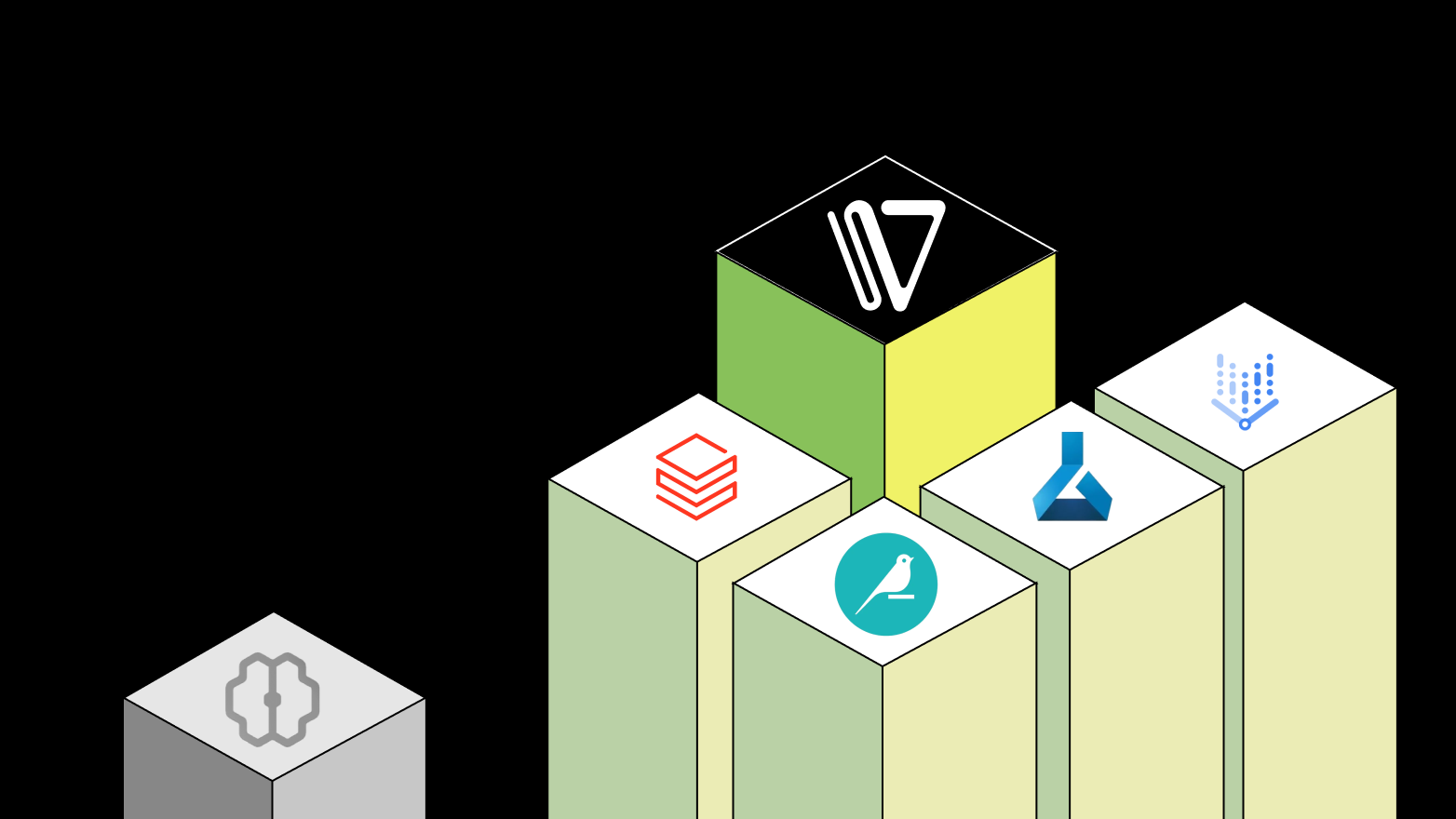Best Open-Source Analytics Tools for Data-Driven Decisions

Choosing an analytics tool often feels like a trade-off between features and control. Proprietary platforms might seem easy, but they can be black boxes, locking your data into their systems and leaving you with questions about privacy. This is why so many businesses are turning to open-source solutions. They offer transparency and the ability to fully own your data pipeline.
The challenge, however, isn’t just finding the best open-source analytics tools, it’s managing them. The freedom of open-source comes with the responsibility of setup, maintenance, and scaling. This guide walks through top options and what it really takes to make them work for your business.
Key takeaways
- Open-source puts you in the driver's seat—for everything: You gain complete control over your data and avoid licensing fees, but you're also responsible for the entire journey. This includes the initial setup, ongoing maintenance, and scaling the infrastructure as you grow.
- Match the tool to your team's reality, not just its features: Before you choose, get honest about your team's technical skills and what you truly need to measure. A simple tool that gets used is far more valuable than a complex one that gathers dust.
- Look at the total cost, not just the "free" price tag: The real investment in open-source includes your team's time for implementation, training, and support. Planning for these costs—or offloading the technical work to a managed platform like Cake—is the key to a successful outcome.
So, what are open-source analytics tools?
Open-source analytics tools are data analysis platforms with publicly available source code. Unlike proprietary systems, they don’t hide how things work. You can inspect, modify, and extend them as needed—like baking your own cake instead of buying it from the store.
These tools help you collect, store, analyze, and visualize data to support smarter decision-making. Whether you’re tracking app usage, web traffic, or business metrics, they give you full visibility into what’s happening under the hood.
Beyond the licensing benefits, open-source tools give you flexibility to customize and integrate as you see fit. They also evolve rapidly thanks to active communities contributing features, fixes, and security updates.
Why go open-source for your analytics?
When you think of analytics, big-name proprietary tools probably come to mind first. They’re popular for a reason, but they aren’t your only option. Choosing an open-source tool is a strategic move that gives you more control over your data and your tech stack. It’s about building an analytics platform that truly fits your business, rather than fitting your business into a pre-packaged box.
One of the most significant advantages is cost-effectiveness. Open-source analytics tools typically don't come with the hefty licensing fees you find with proprietary software. This frees up your budget for other important things, like hiring great engineers or investing more in product development. The cost savings can be substantial, especially as your business scales and your data volume grows.
Beyond the price tag, you get incredible flexibility. With open-source software, you have access to the source code, allowing you to tailor the tool to your exact needs. Need a specific integration that a proprietary tool doesn’t offer? You can build it. Want to create custom reports that match your unique KPIs? You can do that, too. This level of flexibility and customization means your analytics platform can evolve right alongside your business.
Finally, you’re not going it alone. Open-source tools are backed by active communities of developers and users who are constantly improving the software and helping each other out. If you run into a problem, chances are someone has already found a solution. This robust community support is like having a global team of experts on call. This transparency also extends to security, as anyone can inspect the code for vulnerabilities, leading to more secure and trustworthy software.
5 great open-source analytics tools to consider
Whether you’re building a lightweight dashboard or a complex data pipeline, open-source analytics tools give you full control over how your data is stored, queried, and visualized. Below are five high-performance tools used by modern teams today—all of which can be seamlessly orchestrated together with Cake.
1. Unity Catalog
 If you’re managing analytics across multiple teams and tools, metadata governance quickly becomes a pain point. Unity Catalog gives you a centralized way to manage data access policies, track lineage, and audit usage across your entire analytics stack. It’s particularly useful for organizations that need to enforce granular permissions or meet compliance requirements like HIPAA or SOC 2. Unity Catalog works well alongside open compute engines like Apache Spark or Snowflake, helping ensure that everyone’s working from a single source of truth.
If you’re managing analytics across multiple teams and tools, metadata governance quickly becomes a pain point. Unity Catalog gives you a centralized way to manage data access policies, track lineage, and audit usage across your entire analytics stack. It’s particularly useful for organizations that need to enforce granular permissions or meet compliance requirements like HIPAA or SOC 2. Unity Catalog works well alongside open compute engines like Apache Spark or Snowflake, helping ensure that everyone’s working from a single source of truth.
2. Snowflake
 While Snowflake itself is a commercial product, it plays a major role in open analytics workflows thanks to its open standards, SQL-based access, and broad integration ecosystem. It’s a powerful cloud data platform for structured and semi-structured data, making it a popular choice for teams that want enterprise-grade performance without the infrastructure overhead. Snowflake can serve as the storage and query layer for many open-source BI tools like Superset or AutoViz. It’s a great option when you want scale, speed, and compatibility without locking yourself into a proprietary analytics suite.
While Snowflake itself is a commercial product, it plays a major role in open analytics workflows thanks to its open standards, SQL-based access, and broad integration ecosystem. It’s a powerful cloud data platform for structured and semi-structured data, making it a popular choice for teams that want enterprise-grade performance without the infrastructure overhead. Snowflake can serve as the storage and query layer for many open-source BI tools like Superset or AutoViz. It’s a great option when you want scale, speed, and compatibility without locking yourself into a proprietary analytics suite.
3. Apache Superset
 Apache Superset is one of the most powerful open-source business intelligence tools available. It supports rich dashboards, ad-hoc exploration, and a wide array of visualizations—from standard bar charts to geospatial mapping. Superset connects to virtually any SQL-speaking data source, and is trusted by some of the world’s largest companies to power internal analytics. The trade-off is that it requires some technical setup, but once deployed, it empowers both analysts and non-technical users to explore data with ease.
Apache Superset is one of the most powerful open-source business intelligence tools available. It supports rich dashboards, ad-hoc exploration, and a wide array of visualizations—from standard bar charts to geospatial mapping. Superset connects to virtually any SQL-speaking data source, and is trusted by some of the world’s largest companies to power internal analytics. The trade-off is that it requires some technical setup, but once deployed, it empowers both analysts and non-technical users to explore data with ease.
4. AutoViz
 Exploratory data analysis (EDA) is often the first step in understanding a dataset—but doing it manually can be time-consuming. Autoviz automates this process, generating a wide range of visualizations and statistical summaries with minimal input. It’s particularly valuable for data scientists and ML engineers who need quick insights before modeling, or for product teams who want to surface patterns without writing custom code. As part of a larger stack, Autoviz helps accelerate the insight-to-action loop.
Exploratory data analysis (EDA) is often the first step in understanding a dataset—but doing it manually can be time-consuming. Autoviz automates this process, generating a wide range of visualizations and statistical summaries with minimal input. It’s particularly valuable for data scientists and ML engineers who need quick insights before modeling, or for product teams who want to surface patterns without writing custom code. As part of a larger stack, Autoviz helps accelerate the insight-to-action loop.
5. Apache Spark
 When it comes to distributed data processing, Apache Spark remains the gold standard. It supports both batch and streaming workloads, and its flexibility makes it ideal for everything from ETL to machine learning. For analytics use cases, Spark often serves as the engine behind data transformations and aggregations before data is piped into BI tools. If you’re working with large datasets or require real-time processing, Spark is essential to keeping your analytics infrastructure fast and scalable.
When it comes to distributed data processing, Apache Spark remains the gold standard. It supports both batch and streaming workloads, and its flexibility makes it ideal for everything from ETL to machine learning. For analytics use cases, Spark often serves as the engine behind data transformations and aggregations before data is piped into BI tools. If you’re working with large datasets or require real-time processing, Spark is essential to keeping your analytics infrastructure fast and scalable.
How Cake brings it all together
Open-source analytics tools give you power and control—but getting them to work together is where most teams get stuck. You might use Superset for dashboards, Spark for processing, and Unity Catalog for governance, but each of those tools has its own deployment model, config files, permissions structure, and scaling challenges. Integrating them into a single, reliable system can eat up weeks of engineering time—and that’s before you even get to the part where your team actually uses the data.
That’s the gap Cake fills. Cake provides a modular, cloud-agnostic AI infrastructure platform that lets you assemble a production-grade analytics stack from best-in-class open components—without needing to manage the plumbing yourself.
With Cake, you can:
-
Spin up fully integrated analytics pipelines in minutes, not weeks, using pre-configured components like Superset, Spark, Snowflake, and Unity Catalog
-
Enforce fine-grained access control and metadata governance across your stack, without having to write custom IAM policies or sync separate permission models
-
Scale effortlessly as your data grows—Cake auto-manages the underlying compute and storage so your dashboards stay fast and reliable no matter how complex your workloads get
-
Keep your analytics stack flexible and future-ready, with the ability to swap in new tools or add capabilities like AI inference, data labeling, or observability without refactoring your core setup
Whether you’re building an internal analytics hub or laying the foundation for an AI-driven data strategy, Cake gives you the infrastructure to move faster—without sacrificing control, compliance, or performance. You get all the benefits of open-source with none of the infrastructure debt.
IN DEPTH: How Leading Companies Build AI-Powered Analytics With Cake
What to look for in an open-source analytics tool
Choosing an open-source analytics tool isn't just about picking the one with the most buzz. You need to find a tool that fits your team's skills, your company's goals, and your existing tech stack. It’s a bit like finding the right pair of running shoes—what works for a marathoner might not be right for a casual jogger. To make the right choice, focus on a few key areas: how much control you'll have, what features you actually need, and how the tool will grow with you.
Flexibility and control
One of the biggest draws of open-source is the freedom it offers. Look for a tool that gives you the flexibility to customize it to your specific needs. Can you build your own dashboards or tweak the interface? Even more important is the ability to self-host the tool, which gives you complete control over your data. This is crucial for privacy and security. You should also check how easily it integrates with your other systems, like your CRM or data warehouses, to create a seamless workflow instead of another silo.
Features and usability
A long list of features doesn't mean much if your team can't use them. The ideal tool strikes a balance between powerful, advanced capabilities for your data analysts and a user-friendly interface for everyone else. Does it have clear, built-in analysis views that make it easy to spot trends without writing complex queries? Active maintenance is another non-negotiable; you want a tool that is consistently updated and improved by its developers, so it stays secure and effective over time.
Scalability and support
Think about your future needs, not just your current ones. A good analytics tool should be able to handle your data as your business grows. Consider how it performs with larger datasets and more users. Equally important is the community behind the tool. A strong, active community is one of the best assets of open-source software. It’s your go-to resource for troubleshooting, finding plugins, and getting advice when you’re stuck. A vibrant community often means the tool is well-supported and here to stay.
How easy are these tools to set up and scale?
Let's talk about what it actually takes to get one of these tools up and running. While the idea of a free tool is fantastic, it's important to know that "free" doesn't always mean "effortless." The initial setup can be more involved than with a paid, out-of-the-box solution. You're not just installing software; you're often configuring servers, databases, and integrations yourself. Many organizations run into challenges in implementing web analytics software, especially when it comes to connecting it with their existing systems. This often requires someone with technical skills to get everything talking to each other correctly.
Once you're set up, the next thing to think about is growth. What happens when your user base doubles, or you start collecting ten times more data? Scaling an open-source analytics tool means you're responsible for scaling the infrastructure behind it. This can get complicated. As your data grows, you might face new challenges IT faces using open source data management, like ensuring you have access to real-time insights and accurately predicting your infrastructure costs. It’s a solvable problem, but it’s one you need to plan for from the beginning.
This might sound a bit daunting, but here’s the good news: you’re not on your own. One of the biggest strengths of the open-source world is its robust community support. When you hit a snag during setup or run into a scaling issue, there’s a good chance someone else has already solved it. You’ll find extensive documentation, active forums, and community channels where you can ask questions and get help from developers and other users. This collaborative spirit is what makes handling the technical side of open-source tools entirely possible.
How open-source tools handle data privacy and compliance
One of the biggest reasons businesses turn to open-source analytics is for better control over data privacy. For many of these tools, privacy isn't an afterthought; it's a core part of their design. Unlike some proprietary platforms that send your customer data to third-party servers, many open-source options give you complete authority over your information. This shift in ownership is fundamental to building trust with your users and meeting modern data protection standards.
The key to this control is the ability to self-host their data. When you host the analytics platform on your own servers, you decide exactly what information is collected, how it's stored, and who can access it. This means you’re not handing over sensitive user data to another company whose privacy practices might be unclear. You have the final say, which allows you to create a data environment that aligns perfectly with your company’s privacy policies and your customers' expectations.
This level of control is also incredibly helpful for regulatory compliance. Navigating laws like GDPR and CCPA can be complex, but it becomes much more straightforward when you own the entire data pipeline. You can easily track data, respond to user deletion requests, and demonstrate that you are handling information responsibly. Having this direct oversight is crucial for compliance and can protect you from hefty fines. Of course, the responsibility still falls on you to configure the tools correctly and maintain strong internal governance, which is where working with a managed platform can make the process much smoother.
How to solve the common challenges of open-source tools
While open-source analytics tools offer incredible flexibility and power, they aren't always a simple plug-and-play solution. Adopting them successfully means being prepared for a few common hurdles. The good news is that with a bit of foresight, you can handle these challenges and get the most out of your new tool. The key is to go in with a clear plan for implementation, maintenance, and team enablement.
Managing the infrastructure, integrations, and ongoing support for these tools can feel like a full-time job. This is where a managed platform can be a game-changer. By using a solution like Cake, you can offload the technical heavy lifting. We handle the entire stack—from the compute infrastructure to the platform elements—so your team can skip the complex setup and focus directly on using data to drive your business forward.
Plan for the total cost of ownership
The word "free" in open-source can be misleading. While you don't pay a licensing fee, there are other costs to consider. Think of it as getting a "free" puppy—the initial cost is zero, but you're still responsible for food, training, and vet bills. You’ll need to account for the time your team spends on installation, maintenance, and troubleshooting. A thorough cost-benefit analysis will help you understand the actual investment required and ensure the value you get outweighs the resources you put in.
Create a clear implementation strategy
Jumping into a new tool without a plan is a recipe for frustration. Before you start, it’s crucial to develop a clear strategy. This means conducting a full assessment of the resources you'll need, including the right infrastructure and personnel. Define what success looks like with specific metrics, set realistic timelines, and make sure you have buy-in from all the key stakeholders. A structured approach helps keep everyone on the same page and your project on track from day one.
Invest in training and support
A powerful analytics tool is only effective if your team knows how to use it. One of the biggest mistakes businesses make is failing to budget for proper training. Set aside time and resources to help your team get comfortable with the new software. Providing ongoing education and support empowers your employees to explore the tool's full potential. This investment pays off by enabling your team to make smarter, more confident data-driven decisions.
BLOG: How Cake Helps Teams Save $500k to $1M+ Per LLM Project Annually
How to choose the right tool for your business
Okay, we've walked through some fantastic open-source options. But looking at a list of tools is one thing; picking the right one for your business is another. The best tool isn't the one with the most features—it's the one that fits your goals, your team, and your budget. To make the right choice, you need to ask the right questions.
-
Assess your actual needs. Before you get dazzled by features, get clear on what you need to measure. Are you focused on simple website traffic, or do you need to track complex user journeys inside an app? Some tools are brilliant for straightforward analytics, while others offer a more comprehensive solution for deep event tracking and funnels. Make a list of your must-have metrics to filter out the noise and focus on what truly matters.
-
Be realistic about your team's skills. An advanced tool is useless if no one can use it. Be honest about the technical expertise you have in-house. Some platforms are designed for simplicity, while others require a deeper understanding of server management and data engineering. Choose a tool for the team you have right now, not the one you hope to hire someday.
-
Factor in infrastructure and cost. Self-hosting gives you control, but it comes with costs for servers and maintenance. Check the hosting requirements and consider whether your current setup can handle the load. While many tools are free to start, it's wise to evaluate the long-term cost considerations as your data grows. Sometimes, a managed cloud version is a great middle ground, offering predictability without the infrastructure headache.
What's next for open-source analytics?
The world of open-source analytics is anything but static. As more organizations prioritize making data-driven decisions, the demand for flexible and powerful tools is growing. This momentum is what fuels the constant innovation within the open-source community. We’re seeing platforms evolve quickly, with robust community support leading to new features and better performance all the time. It’s a collaborative effort that benefits everyone who uses these tools.
As these platforms become more capable, the conversation around them is also maturing. It’s shifting from a simple focus on cost savings to a more holistic view of value. Businesses are learning that the initial allure of "free" software needs to be balanced with practical considerations. The future of open-source analytics involves a deeper understanding of what it takes to maintain, secure, and scale these tools effectively. The focus is moving toward total cost of ownership and long-term sustainability.
Looking ahead, we can expect to see a few key trends. Integration will be a major focus, with tools becoming easier to connect to existing systems and data stacks. We’ll also see a greater emphasis on built-in security and compliance features to meet growing regulatory demands. This means organizations will need to carefully evaluate their specific requirements to find the right fit. Successfully using these powerful tools will depend on having a solid strategy for managing the technical complexities, from initial setup to ongoing operations.
How Cake helps you get more from your open-source tools
While open-source tools offer incredible power and flexibility, getting them to work together seamlessly can feel like a full-time job. You might find the perfect tool for data visualization and another for data processing, but making them communicate is a significant technical hurdle. This is where the real challenge often lies—not in finding the tools, but in managing the complex web of infrastructure, integrations, and maintenance required to make them useful.
This is precisely the problem Cake was built to solve. Instead of leaving you to stitch everything together, Cake provides an AI development platform that lets you assemble the analytics stack you want using hundreds of pre-integrated open-source components. Think of it as having all the best ingredients and a professional kitchen at your disposal. You can bring powerful tools into your analytics workflows, orchestrating pipelines and connecting data sources without the engineering headache.
This approach allows your team to build a custom, best-in-class analytics solution tailored to your exact needs. You get the freedom and transparency of open-source without the operational burden. Cake handles the entire underlying stack—from the compute infrastructure to the platform elements and integrations. This means your tools are not only connected but also secure, scalable, and production-ready from day one. It frees up your team to focus on what actually matters: using data to make smarter decisions and drive your business forward.
Related articles
- 6 of the Best Open-Source AI Tools of 2025 (So Far)
- The High Cost of Sticking with Closed AI
- Analytics | Cake AI Solutions
- 9 Best Data Ingestion Tools: A Deep Dive Review
Frequently asked questions
Are open-source analytics tools actually free?
While you don't pay a licensing fee for the software itself, "free" doesn't mean there are no costs. You need to account for the resources required to run the tool, which includes server hosting, maintenance, and the time your technical team spends on setup and updates. Think of it as the total cost of ownership—you're trading a subscription fee for the cost of managing the infrastructure yourself.
Do I need a team of engineers to use an open-source tool?
Not necessarily, but it depends on the tool and how you plan to use it. Some simpler tools are designed for non-technical users to get basic insights quickly. However, setting up, customizing, and scaling most open-source platforms requires technical know-how. If you plan to self-host or integrate the tool deeply with other systems, having someone with engineering skills on your team is essential for a smooth experience.
What’s the main advantage of self-hosting my analytics?
The biggest advantage of self-hosting is complete data ownership. When you host the tool on your own servers, you have full control over what information is collected and where it's stored. This means you aren't sending sensitive customer data to a third-party company, which is a huge benefit for maintaining privacy and complying with regulations like GDPR.
How do I choose between a simple tool and a more complex one?
The right choice comes down to your business goals. If you just need to understand website traffic and see which pages are popular, a simple, lightweight tool is perfect. If your goal is to connect multiple databases, let your team build complex custom dashboards, and perform deep data exploration for an AI project, you'll need a more powerful business intelligence platform. Start by defining what you need to measure, and then find the tool that matches that scope.
If the tools are open-source, why would I need a platform like Cake?
Using open-source tools often means you have to manage the complex infrastructure and integrations yourself, which can be a huge drain on your engineering resources. A platform like Cake handles all of that for you. We manage the entire stack—from servers to security and updates—so you can use powerful open-source components without the operational burden. It gives you the flexibility of open-source with the convenience of a managed service.
About Author

Cake Team
More articles from Cake Team
Related Post

7 Best Open-Source AI Governance Tools Reviewed

Cake Team

Top Open-Source AIOps Tools for Peak IT Performance

Cake Team

Beyond SageMaker: AI Platforms Built for Speed, Data Control, and Security

Cake Team

Best Open-Source MLOps Tools to Build Your ML Stack

Cake Team